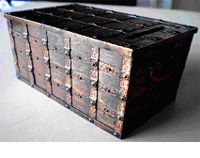Wards. protrusions or obstructions, usually mounted in lock fittings or in the keyway. The correct key has notches or grooves in the bit for each ward.
Fittings. In this context, decorative reinforcements of iron or other metal on doors (hinges), windows, shutters, chests, furniture and so on.
Blue tempering. Decoration and rust protection of iron or steel surfaces. The method is simple; the smooth-filed surface is polished and heated to a deep blue color, which remains after cooling.
Etching. Locks have been decorated with etching since the 16th century. The fine-ground and polished iron surfaces were coated with an acid-resistant substance and the uncovered surfaces were then burned away using acid.
Springs. Springs have been crucial to the design and function of locks throughout history. The Romans used springs as wards in padlocks and in pin tumbler locks. Ward spring locks are found in Scandinavia from the Viking Era until well into the 18th century. Various types of springs could also be used in the locks on doors and chests. Prior to 1600 they were V-shaped; after that they were spirals. The early springs were made of cold-hammered iron, making them very rugged. Trunk locks generally have ring-shaped springs.
Actuator. Any part of a lock that transfers the movement of the key to the bolt.
Engraving. A method of decoration in which grooves are cut into a cold metal (or wood) surface with a sharp chisel-like cutting tool called a burin or graver. There is no raised edge, as there would be with impressing. The engraved line is soft and unbroken, while the impression is composed of a series of pressed-in markings.
Hammered inlay. A (rare) method of decorating an iron surface with precious metals, by hammering them onto the roughened surface.
 |
| Savings box. Helsingfors Sparbank. Miniature money chest made of plastic. Photo by the author. |